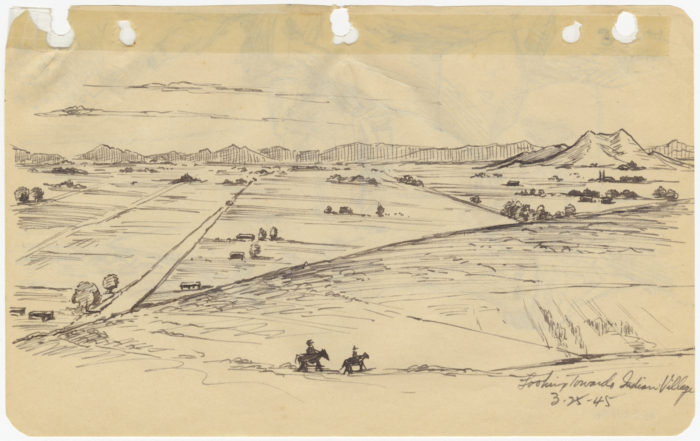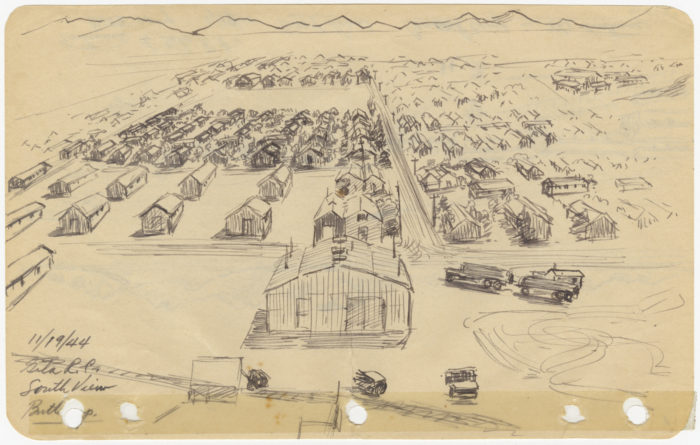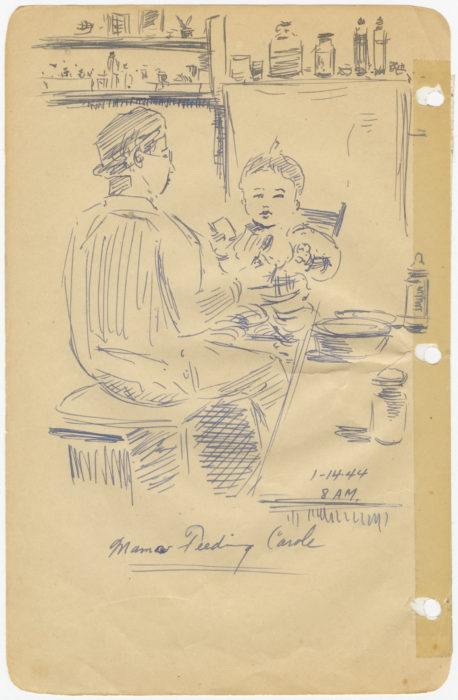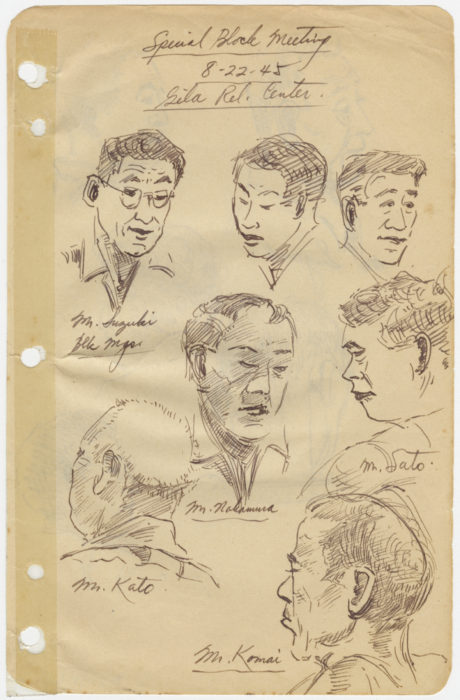Double Oppression

George Hoshida, Untitled (Looking Towards Indian Village 3-25-45), 1945, ink on paper, Japanese American National Museum, Gift of June Hoshida Honma, Sandra Hoshida, and Carole Hoshida Kanada (96.117.354)
Click to open full-size image in new tab.Look closely at this drawing.
- What do you notice in the foreground, middle ground, and background?
- What kind of climate is depicted?
- Where do you think this drawing was made?
- When was this drawing made?
- What questions do you have about this drawing?

George Hoshida, Untitled (Entrance to Gila R. C. Butte Camp 11/19/44), 1944, ink on paper, Japanese American National Museum, Gift of June Hoshida Honma, Sandra Hoshida, and Carole Hoshida Kanada (96.117.350)
Click to open full-size image in new tab.- What is the first thing you notice when you see this drawing?
- Who might live here?
- What kind of community could this be?
The Gila River War Relocation Center was one of the two Japanese American incarceration sites located on Native American reservations in the Sonora Desert in Arizona. The Bureau of Indian Affairs had jurisdiction over the Gila River and its 13,348 inmates. The land was leased by the Bureau of Indian Affairs from the Akimel O’otham (Pima) and Pee-Posh (Maricopa) Indians of the Gila River Indian Community. The summer temperatures were over 100 degrees and the barracks were poorly insulated; many inmates made swamp coolers to find relief from the heat.

George Hoshida, Untitled (Mama Feeding Carole 1-14-44 8AM), 1944, ink on paper, Japanese American National Museum, Gift of June Hoshida Honma, Sandra Hoshida, and Carole Hoshida Kanada (96.117.345)
Click to open full-size image in new tab.This is a drawing of the artist’s wife and young daughter.
- What is happening in this picture?
- What details are you most drawn to?
- Where could this scene have taken place?
This sketch captures a mother feeding a young child on a typical morning at the concentration camp in Gila River. Despite the circumstances of incarceration, parents tried to make life normal for their families. This included making do with the food served at the mess hall to feed to small children.

George Hoshida, Untitled (Special Block Meeting 8-22-45 Gila Rel. Center),1945, ink on paper, Japanese American National Museum, Gift of June Hoshida Honma, Sandra Hoshida, and Carole Hoshida Kanada (96.117.357)
Click to open full-size image in new tab.- Have you ever sketched the people around you?
- Who might these people be?
- What do they have in common?
- What is different about all of them?
- At the top of the paper, the artist has written: “Special Block Meeting.” What do you think this special block meeting might be?
The Japanese Americans at each camp were separated by blocks and divided in the barracks by family. By the fall of 1942, despite this undemocratic situation, they organized themselves by electing representatives for temporary community councils. However, the War Relocation Authority imposed a rule that only US citizens could serve on these councils. This favored the American-born Nisei, many of whom were in their teens or early twenties, and not the actual community leaders. To circumvent this issue, each block democratically elected one block manager; those elected were often Japanese-speaking Issei or bilingual Kibei. The block managers were tasked with distributing supplies, handing out mail, and communicating the inmates’ concerns to the management.

George Hoshida, Untitled (Looking Towards Indian Village 3-25-45), 1945, ink on paper, Japanese American National Museum, Gift of June Hoshida Honma, Sandra Hoshida, and Carole Hoshida Kanada (96.117.354)
Click to open full-size image in new tab.Gila River, Arizona, is the home of the Akimel O’otham (Pima) and Pee-Posh (Maricopa) Indians of the Gila River Indian Community. With the formation of the Gila River War Relocation Center, both the Native Americans and Japanese Americans were oppressed at once. The government imposed its authority upon the Native American community, leasing reservation land in order to facilitate the incarceration of the Japanese American community as a wartime necessity. In this case, justice and democracy for these two ethnic groups were suspended due to governmental priorities that were not in accord with American democratic principles.
Return to Justice & Democracy
